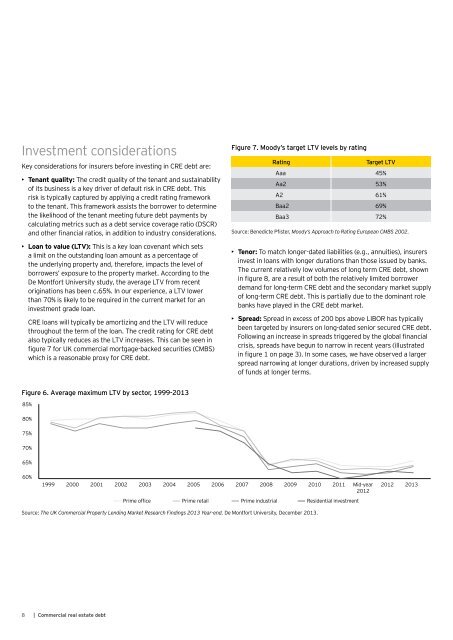EY-commercial-real-estate-debt
EY-commercial-real-estate-debt
EY-commercial-real-estate-debt
- No tags were found...
Create successful ePaper yourself
Turn your PDF publications into a flip-book with our unique Google optimized e-Paper software.
Investment considerations<br />
Key considerations for insurers before investing in CRE <strong>debt</strong> are:<br />
• Tenant quality: The credit quality of the tenant and sustainability<br />
of its business is a key driver of default risk in CRE <strong>debt</strong>. This<br />
risk is typically captured by applying a credit rating framework<br />
to the tenant. This framework assists the borrower to determine<br />
the likelihood of the tenant meeting future <strong>debt</strong> payments by<br />
calculating metrics such as a <strong>debt</strong> service coverage ratio (DSCR)<br />
and other financial ratios, in addition to industry considerations.<br />
• Loan to value (LTV): This is a key loan covenant which sets<br />
a limit on the outstanding loan amount as a percentage of<br />
the underlying property and, therefore, impacts the level of<br />
borrowers’ exposure to the property market. According to the<br />
De Montfort University study, the average LTV from recent<br />
originations has been c.65%. In our experience, a LTV lower<br />
than 70% is likely to be required in the current market for an<br />
investment grade loan.<br />
CRE loans will typically be amortizing and the LTV will reduce<br />
throughout the term of the loan. The credit rating for CRE <strong>debt</strong><br />
also typically reduces as the LTV increases. This can be seen in<br />
figure 7 for UK <strong>commercial</strong> mortgage-backed securities (CMBS)<br />
which is a reasonable proxy for CRE <strong>debt</strong>.<br />
Figure 7. Moody’s target LTV levels by rating<br />
Rating<br />
Target LTV<br />
Aaa 45%<br />
Aa2 53%<br />
A2 61%<br />
Baa2 69%<br />
Baa3 72%<br />
Source: Benedicte Pfister, Moody’s Approach to Rating European CMBS 2002.<br />
• Tenor: To match longer-dated liabilities (e.g., annuities), insurers<br />
invest in loans with longer durations than those issued by banks.<br />
The current relatively low volumes of long term CRE <strong>debt</strong>, shown<br />
in figure 8, are a result of both the relatively limited borrower<br />
demand for long-term CRE <strong>debt</strong> and the secondary market supply<br />
of long-term CRE <strong>debt</strong>. This is partially due to the dominant role<br />
banks have played in the CRE <strong>debt</strong> market.<br />
• Spread: Spread in excess of 200 bps above LIBOR has typically<br />
been targeted by insurers on long-dated senior secured CRE <strong>debt</strong>.<br />
Following an increase in spreads triggered by the global financial<br />
crisis, spreads have begun to narrow in recent years (illustrated<br />
in figure 1 on page 3). In some cases, we have observed a larger<br />
spread narrowing at longer durations, driven by increased supply<br />
of funds at longer terms.<br />
Figure 6. Average maximum LTV by sector, 1999-2013<br />
85%<br />
80%<br />
75%<br />
70%<br />
65%<br />
60%<br />
1999 2000 2001 2002 2003 2004 2005 2006 2007 2008 2009 2010 2011 Mid-year<br />
2012<br />
Prime office Prime retail Prime industrial Residential investment<br />
2012 2013<br />
Source: The UK Commercial Property Lending Market Research Findings 2013 Year-end, De Montfort University, December 2013.<br />
8 | Commercial <strong>real</strong> <strong>estate</strong> <strong>debt</strong>


